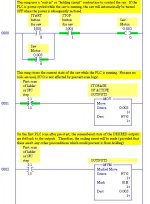Re: I guess I'll take that as a compliment ...
Glad you took it as a compliment - that is absolutely how it was meant!
Don't I know it. You make some of the best posts on the board (particularly on issues like this). That's part of why I keep coming back . . .
I also don't want to start an argument, but anyone who doesn't buy 100% into what Ron said in this quote should re-read everything that Ron posted in this thread.
Latches (or 'sets') can be dangerous if used improperly. Seal-in construction can also be dangerous if used improperly. MANY of the "to latch or not to latch" questions MUST be answered by answering (A) and (B) above.
ONLY in the cases where safety is NOT an issue should other drivers/preferences be considered. In these "non-safety" cases, 99 times out of 100 I think that the ease of troubleshooting the "use-once" seal-in construction outweighs the scan time improvements that might be possible with other constructions.
Marc
Glad you took it as a compliment - that is absolutely how it was meant!
Originally posted by Ron Beaufort
they ain't all that easy to write either ...
Don't I know it. You make some of the best posts on the board (particularly on issues like this). That's part of why I keep coming back . . .
Originally posted by Ron Beaufort
there can be !SERIOUS! !SAFETY! !ISSUES! involved when deciding whether to use – or not to use – retentive instructions such as latches! ...
let me spell this out:
(A) sometimes you SHOULD use a latch ...
(B) sometimes you should NOT use a latch ...
there is a LOT more to consider when making this decision than just your personal preferences about what “looks neater” and what makes for “easier troubleshooting” ...
I also don't want to start an argument, but anyone who doesn't buy 100% into what Ron said in this quote should re-read everything that Ron posted in this thread.
Latches (or 'sets') can be dangerous if used improperly. Seal-in construction can also be dangerous if used improperly. MANY of the "to latch or not to latch" questions MUST be answered by answering (A) and (B) above.
ONLY in the cases where safety is NOT an issue should other drivers/preferences be considered. In these "non-safety" cases, 99 times out of 100 I think that the ease of troubleshooting the "use-once" seal-in construction outweighs the scan time improvements that might be possible with other constructions.
Marc






